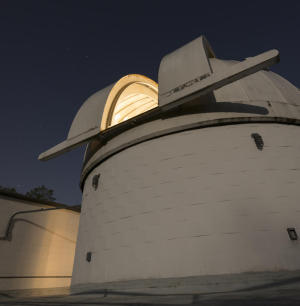
The Whole Earth Telescope (WET), a worldwide network of observatories with its command center at the University of Delaware, periodically focuses on stars of scientific interest in the galaxy's stellar graveyard.
Working together like a relay team, observers in 17 countries, from the U.S. to China, Brazil to Ukraine, have been focusing their lenses on these target stars whenever they appear in their nighttime sky, effectively operating as a single telescope.

The command center for the Whole Earth Telescope, coordinated by the University of Delaware, is based at Mount Cuba Astronomical Observatory in Greenville, Del. (Credit: Evan Krape/University of Delaware)
With a marathon two-month-plus observing campaign set to finish up on June 10 -- the longest in WET's history -- the collaboration expects to yield new insights into the astrophysics of white dwarfs, which are dense stars that have burned up their nuclear fuel and are now cooling.
"White dwarfs are so dense that one tablespoon of their matter would weigh as much as five elephants," says Judi Provencal, director of the Delaware Asteroseismic Research Center at the University of Delaware. Provencal operates the WET command center at Mount Cuba Astronomical Observatory in Greenville, Del.
The WET team hopes to shed light on the inner workings of these stars, which naturally pulsate, or vibrate.
The team's primary target, the extremely low-mass white dwarf known as WDJ1518, was once part of a two-star or binary system, before eating its companion -- or at least part of it. Discovered only about a year ago by doctoral student J.J. Hermes at the University of Texas at Austin, WDJ1518 is now in a 14-hour orbit around something that is probably another white dwarf or a brown dwarf, according to Provencal. While a white dwarf is massive, a brown dwarf is so light that it can't sustain the nuclear fusion that fuels other stars.
WET's second target star, GD358, waxes and wanes in brightness as the star pulsates, just as other white dwarfs do.
"If you tried to stand on the surface of a white dwarf, you would be squished because it is so dense," Provencal explains. "So, since it would take a large amount of energy to actually expand and contract, white dwarfs slosh from side to side, like an energy wave traveling along the surface."
Astronomers record changes in a white dwarf's luminosity in graphs of light intensity over time called light curves. These graphs typically show regularly repeating sinusoidal waves like a patient's heartbeat or the sound of a ringing bell.
Nearly 20 years ago, in August 1996, GD358 committed what astronomers refer to as a "whoopsie," a period of extreme oscillations that, plotted on a light curve, mimics the track of a monster rollercoaster gone wild.
After two days of giant peaks and dips, the star stopped pulsating for a month, according to Provencal, who began studying it when she was in graduate school.
"It quivered like a bowl of Jell-O for a month," she says. "'Why did it do that, we wondered -- did an asteroid hit it?"
When the WET campaign officially concludes in mid-June, nearly 200 gigabytes of images will have been gathered. Over the next several months, the photos will be stitched together digitally and analyzed to help uncover what's really going on inside these dead stars as they continue to cool down, a mystery that astronomers would like to solve.
"This Whole Earth Telescope run has produced the best investigation of extremely low mass white dwarfs, a newly discovered class of objects," Provencal says. "We have also gathered the best light curve of GD358 ever obtained, and we have seen the star alter its pulsations as we watched. All of this will yield new insights into the structure of white dwarfs and help us understand the future of our own sun, which is destined to become a white dwarf in about 4 billion years."
Such research achievements underscore how the Whole Earth Telescope can help fill a void in astronomy, according to Provencal.
While sophisticated instruments such as the Kepler spacecraft can take detailed images of cosmic phenomena on its hunt for habitable planets, the Whole Earth Telescope offers scientists another avenue for exploration right here from Earth.
"Kepler is looking at one little bit of sky near the constellation Cygnus, so if you want to look somewhere else, you're stuck," she explains. "Kepler covers 0.1 percent of the sky, and we've got the rest of it."
And that "we" includes several amateur astronomers in Texas and Delaware, who are contributing to the WET observing run for the first time.
"Anyone with a telescope and a camera can monitor the brightness of stars right from their backyard," she says.

 Previous page
Previous page Back to top
Back to top







